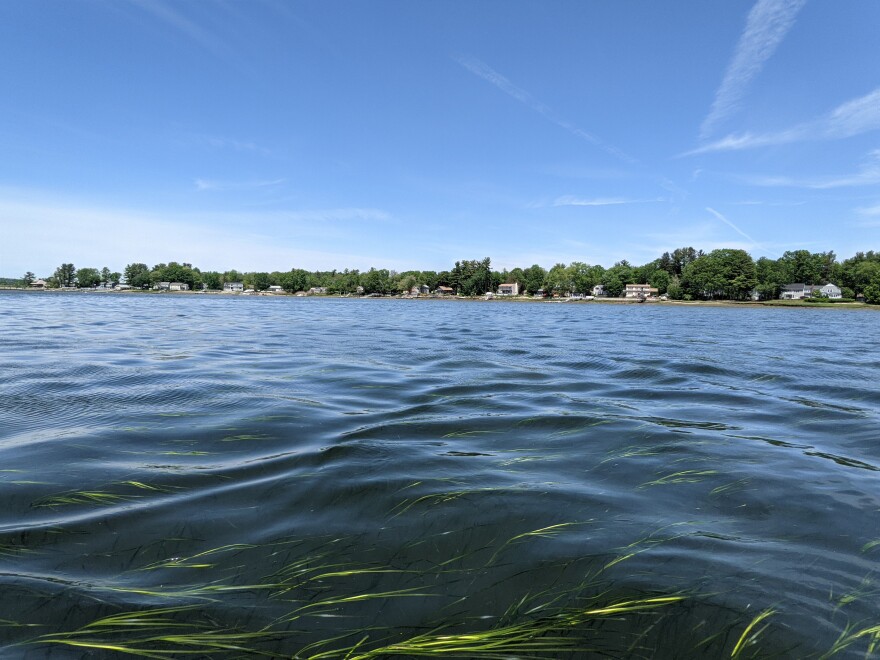This story was originally produced by the New Hampshire Bulletin, an independent local newsroom that allows NHPR and other outlets to republish its reporting.
New Hampshire estuary research receives $4.5 million in federal funding
New Hampshire has lost 80 percent of its oysters in the past 30 years, and nearly as much eelgrass has disappeared. Kalle Matso is working to bring them back.
In May, Matso became the director of the Piscataqua River Estuaries Partnership, a collection of scientists, university researchers, municipalities, and other stakeholders on a mission to better understand the estuary in order to protect and restore it. In July, Matso learned the organization’s budget would more than double, with $4.5 million in additional federal funding from the bipartisan infrastructure law.
“There are so many things that we need to do to improve habitat quality in our watershed,” Matso said. “This is going to help us do that.”
An eelgrass bed in New Hampshire’s Great Bay. (Jerry Monkman photo)
Before Matso became the director of the estuaries partnership, he worked as a coastal scientist, where he found resources were extremely hard to come by. That makes the new federal funding especially exciting, he said.
The money will allow the partnership to expand monitoring and research. Much of the funding will go toward communicating science to the public, an area Matso said has gotten short shrift in recent years.
“A really amazing environment is going to make everyone want to come here, and visit here, and live here,” he said. But that requires investments in the environment, according to Matso. “The only way to make that happen politically is if we do a better job of communicating what’s going on out there,” he said.
Estuaries are a vital ecosystem that contributes to the state’s culture, economy, and environment. But problems brought on by climate change, such as warming water and sea level rise, have harmed this ecosystem, which is also degrading because of development and water contamination from runoff, septic systems, and wastewater treatment.
In order to solve this problem, scientists first have to understand it. One challenge is that these habitats are constantly changing. Plus, they’re out of sight because they’re underwater, so there isn’t the same public awareness about their degradation or importance.
Salt marshes are one part of estuaries that people can see – and they’ve shrunk drastically due to the pressures of development. With sea level rise, the marshes will need to migrate farther inland, but development has left little room for them to do so.
Eelgrass in particular is an indicator of the ecosystem’s overall health. Matso compared it to a canary in a coal mine. It’s sensitive to water pollution so it can indicate when toxins are entering waterways. Eelgrass needs clear water that allows light to enter; too much sediment can block that light from reaching the eelgrass. But eelgrass can also promote those conditions by slowing the flow of water when it grows, decreasing how much sediment is stirred up and how cloudy the water is.
As local communities have upgraded their wastewater treatment plants, it’s helped improve water quality by limiting pollution.
At the same time, eelgrass seems to be doing better, reversing a trend of decline from the 1990s. But scientists need to study this more to verify that changes on the landscape are helping eelgrass’ comeback, not something else like a few years of fluky weather, Matso said.
Oysters, which have been imperiled by parasites, also seem to be making a recovery in the past few years. Unlike eelgrass, oysters don’t need light, Matso said, but they do require both a place to settle and water that is relatively free of sediment. Water with too much sediment makes it harder for oysters to fight off the parasites that have been attacking them all along the East Coast.
Matso said people should aim high when it comes to restoring the estuaries to their prior health of 40 or 50 years ago.
“Let’s set some crazy, audacious goal and show the whole country that you can have a thriving economy and have a really healthy environment too, and in fact it’s not in spite of each other, it’s because of each other,” he said.
New Hampshire Bulletin is part of States Newsroom, a network of news bureaus supported by grants and a coalition of donors as a 501c(3) public charity. New Hampshire Bulletin maintains editorial independence. Contact Editor Dana Wormald for questions: info@newhampshirebulletin.com. Follow New Hampshire Bulletin on Facebook and Twitter.







